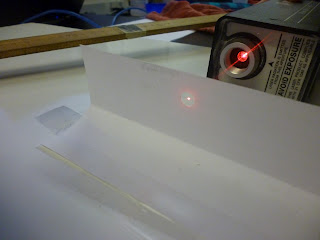The purpose of this experiment
is to understand how the time interval between the occurrence of two events and
the length of an object in space depends on the inertial frame of reference. According
to the relativity of simultaneity, an observer moving with a constant velocity,
comparable to the speed of light, relative to the rest frame sees the clock of
the rest frame to run slower. This is demonstrated by the relationship between
the time interval of the moving and the stationary light clock,
∆t = γ∆t0, (1)
where
∆t is the time interval of the moving light clock, γ is the Lorentz factor, and ∆t0
is the time interval of the stationary light clock. Not only the time interval
but also the observed length differs depending of the frame of reference. An
observer moving with a constant velocity relative to the rest frame sees the
length of an object to be contracted. This idea is also described by a
mathematical relationship,
l= γl0, (2)
where
l represents the length seen by moving observer, and l0 is the
length in the rest frame.
In this experiment, these
concepts were explored by using the animations of relativity of time and length
on <Modern Physics>. The questions given in this website were used as a tool to
analyze these concepts.
Images
Image 1: Image depicting the relativity of time at γ = 1.20
Image 2: Image depicting the relativity of time at γ = 1.12
Image 3: Image depicting the length contraction at γ = 1.41
 |
| Image 4: Image depicting the length contraction at γ = 1.30 |
Conclusion
Image 1 and 2 explain the concept of relativity of
simultaneity. As shown in image 1, the distance travelled by the moving light
clock is larger than that by the stationary light clock. Since the moving light
clock is travelling with a constant velocity, the light pulse leaving the green
object and coming back to this object happen at different positions in space.
Therefore, the path of the light pulse is hypotenuses in the moving light clock.
Since its path is hypotenuses, it takes longer time for the moving light clock
to do the round-trip than the stationary light clock. If I am riding on the
light clock, the time interval of the round-trip of the light pulse does not
change because I am moving with the same speed of the light clock. In my frame
of reference, the light clock is, in this case, always stationary. Thus, the
light pulse leaving the green object and reaching this object will occur at the
same point; hence, the time interval, which is 6.67μs,
remains unchanged. If the velocity of the light clock decreases, the difference
between the stationary and the moving time intervals will decrease since the
moving light clock travels less distance. Therefore, the hypotenuses or the
distance travelled by the light pulse on the moving light clock will approach that
distance by the light pulse on stationary light clock. This is confirmed by
image 1 and 2, in which the time interval of the moving light clock in image 1
is 8 μs and that in image 2 is 7.47 μs. Assuming the Lorentz factor relative to
the earth is 1.2, the time interval records on earth will be 8μs.
This result is confirmed by image 1. Besides, if the time interval of the
moving light clock is 7.45μs, the Lorentz factor will become 1.12 as shown in
image 2. These differences in time values reveal that the observer moving
relative to a rest frame observe the clock of the rest frame to run slower.
Image 3 and 4 explain the length contraction in space.
If I am riding on the left end of the light clock, the time interval for a
pulse of light to travel to the right end and to reflect to the left end of the
light clock will not change whether the light clock is moving or stationary
relative to the earth. This is because I am moving with the light clock, so in
my frame of reference, the light clock is stationary. Therefore, the time
interval will always be 6.67 μs as shown in image 3. However, if I am to
measure the time interval on the earth, the light clock is moving with a
certain speed in my frame of reference. Then the light pulse has to travel
longer than the length of the object; hence, it will take longer time interval
for the light pulse to reflect back to the left end of the light clock. This is
numerically confirmed by image 3, in which the time interval of the stationary
light clock is 6.67 μs and that of the moving light clock is 8 μs. The length
of the moving clock shown in image 3 and 4 are smaller than the stationary
clock due to length contraction. If the lengths are the same, the round-trip
time interval as measured on the earth will not be equal to t0/γ.
This is because the light clock is moving with a certain speed, so the time
interval will become even greater since it has to travel a greater distance. In
mathematical way, in equation 2, γ has to become 1 if the lengths are the same.
This will contradict the situation since the light clock is moving with a speed
comparable to c; thus, γ cannot equal to 1. If the light clock is 1000m long
when measured at rest and the Lorentz factor is 1.3, the earth-bound observer
will measure the length to be 749 m as confirmed in image 4.




















